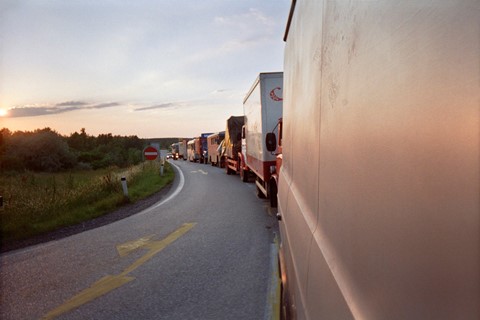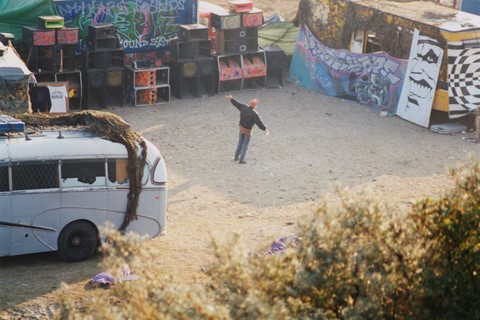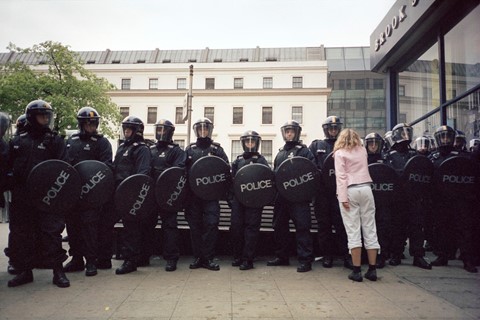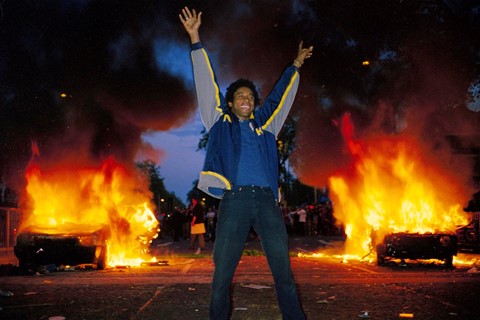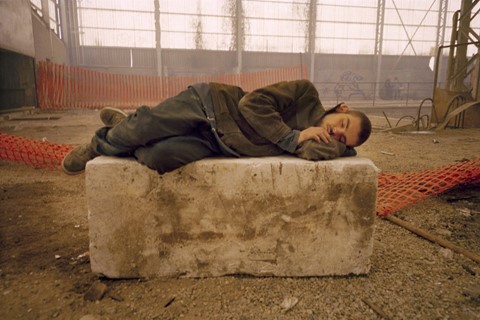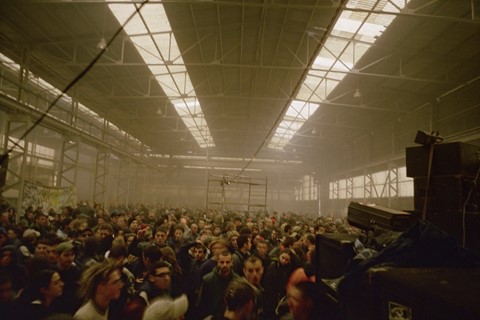In her new solo exhibition Raves and Riots, photographer Vinca Petersen captures a moment of freedom on the cusp of the digital era
In Vinca Petersen’s installation A Life of Subversive Joy, over 700 images and ephemera come together to form a freewheeling look at the photographer’s days travelling and raving with sound systems throughout the 90s. Originally shown as part of the Saatchi Gallery’s 2019 exhibition Sweet Harmony, the sprawling, absorbing installation – currently on show at the V&A in Dundee – is a complete contrast to Petersen’s new solo exhibition Raves and Riots at Edel Assanti, London. The show comprises 15 photographs, drawn from Petersen’s expansive archive of work and collected item. “The ethos of Edel Assanti fits very much with my work – artists engaged with the politics of the moment,” she says over the phone from her home in Ramsgate. “Charlie [Fellowes] from the gallery put in so much groundwork over the last year, looking through the archive and really listening and talking to me. We decided to go back to the essence of it, back to the beginning – it’s a more contemplative show, an introduction to the archive.”
As the show’s title suggests, the 15 photographs all depict various parties and protests Petersen attended and documented over the 90s. (Some of them also feature in her cult book No System, which originally came out in 1999 and was republished in a new edition last year.) Not only do the photographs form a vital record of a unique moment in recent history – on the cusp of a digital era, when there was arguably more freedom to stage gatherings in such a way – but, as Petersen says, they are just as relevant today. “As we were putting the show together we realised it’s completely reflective of right now – so many of the images could be from today,” she explains. “There’s an image called Where Next? which is a group of people sitting and looking at a map of Europe. At the time, it was just us deciding where to go, in an analogue way as you did back then, trying not to get lost. We put it on the wall in the gallery and realised this is Europe, this is what we’re losing. We’re all looking at this thing and it’s slipping through our fingers. The title is Where Next? but then you’re thinking ‘what next?’. That was very poignant.” Here, Petersen shares stories behind the exhibition, and the continued importance of raving and rioting.
“When I was younger, I was unhappy at school, I was unhappy at home, and I met a punk boy with dreadlocks who was wild and interesting. I left home at 17 and went to live in a squat in London. We found out about the rules of making a squat from the old Squatters Handbook, which is still going. I was going to a lot of gigs, listening to a lot of hardcore bands and suddenly started realising there was a huge network of these squats. It was how young people and creatives could live for free, and it was amazing, extraordinary.
“I actually had a fear of raving. I’d heard about raving and ecstasy and it all sounded very frightening, but I went to one, and oh my God, it was brilliant. I loved it so much. I loved the openness of everyone there. The women’s toilets were amazing, you kind of got in there and were lost for an hour chatting to loads of different women. Then I wasn’t with that boy anymore and I went to live in a bigger squat and we would get involved with local sound systems who were putting on raves. I had no idea that this was such a movement and such a politicised way of partying. That was all in London until 1994 when the Criminal Justice Bill came in, and suddenly it was very hard to put on a rave in Britain. So I went abroad. That was really the beginning of No System, it’s from that point on. I bought myself a little live-in vehicle, a Ford Transit and went to live in Europe. And that’s where the rest of the story begins.
“You’d think an exhibition of raves and riots would be all crowd scenes but there’s only a couple. One is called Warehouse Rave, a dancefloor in the pale light of dawn in a huge warehouse, and River Conversation is just after a rave, lots of people standing on a big rock in a river. Both of them actually represent everything we’ve not had for a year. The warehouse rave, where you lose yourself in a crowd and you’ve been dancing all night. What’s nice about that photo is there’s no phones and none of that self-consciousness. No one’s smiling even, they’re just in that state you get into, where you just dance and dance and dance. The other one is standing in the most beautiful river, out in nature, a big group just chatting in the sun. The other ten or so images are all single people in a rave environment or at a protest of some sort. So it really reflects the way we’ve all become solitary as well – the intensity of joy when you’re alone, the intensity of everything. There’s one guy dancing in front of a speaker all on his own and it reminds me of how I’ve been thinking for the last year – really concentrated. But without all of that outlet.
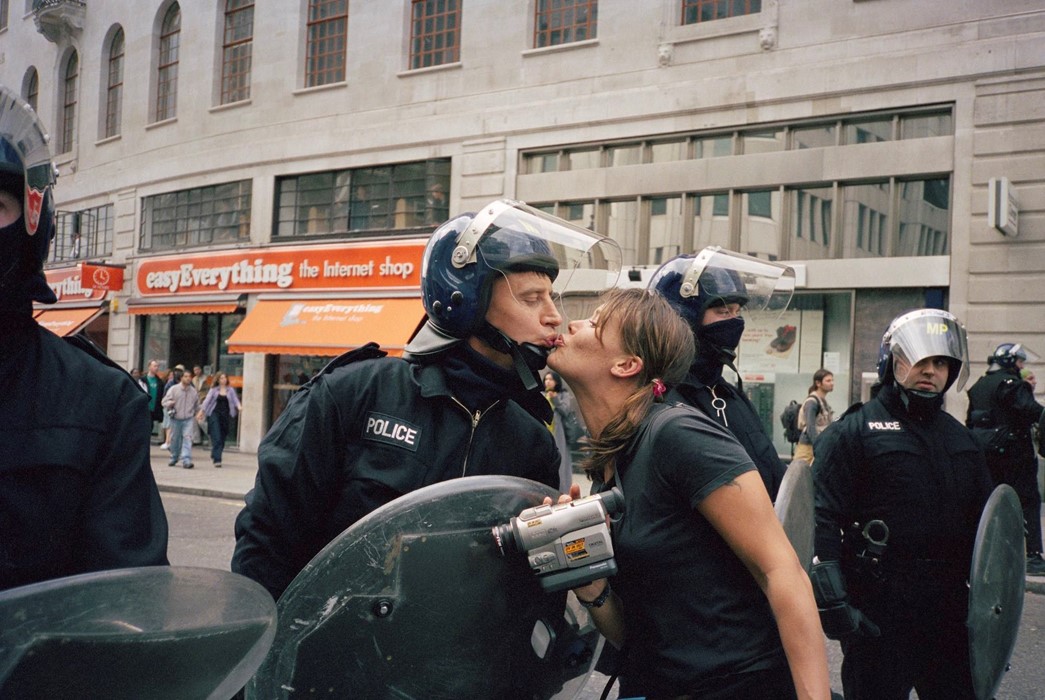
“There’s something that happens in both those environments. In a rave – and I’m talking an illegal rave – just by entering the space you’re breaking the law. You’re entering a lawless environment, to a degree. It’s a very unique environment where people think they can behave differently than everywhere else. It’s the autonomous zone. What I’ve often noticed is the playfulness of people, and the buzz they get – the buzz I used to get just from being in that space. It fills people with a very certain type of energy. It’s the same at protests, when people come from all over the place with a common belief. The sense of community builds and you all start to walk with this shared aim. Something happens where it comes towards the end of the day, and the crowd gets too big and the police start to press in a bit. You suddenly notice your first line of coppers – these days, there’d be riot cops straight away. The minute a normal person thinks a policeman is wrong, you’re shedding this skin of authority because you’re disagreeing with it. That energy is there again, it’s a sense of your own freedom to behave and to think and feel what you believe in. It’s a moment. Of course in extreme protest, when it becomes a riot, that sense of lawlessness which you might feel in a rave, is tenfold.
“Somehow it feels like that moment again. What with the raves that are happening and the protests and a lot of young people very disillusioned with government. Is it a sense of collective consciousness? I can see myself out there in all the young people. It’s like a cycle, rather than something that’s been there all along – it feels like it’s come back. When I work with younger assistants in galleries or talk to young people around here in Ramsgate, it’s so thrilling to hear how switched on so many people are. I grew up in a village in the middle of nowhere, with no internet, no nothing, and it took me a long time to gather information and form ideas. Young people today have got these things at their fingertips and there are some extraordinary young women and men I’ve been meeting. I have great hope in the next generations.”
Vinca Petersen: Raves and Riots is at Edel Assanti, London, until July 30, 2021.

